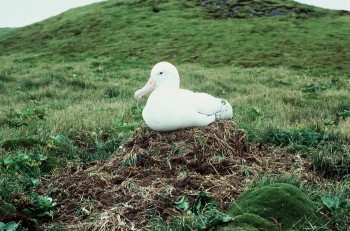
Wandering Albatross breeding on Heard Island: a top predator in the Southern Ocean; photograph by the late Gavin Johnstone
Sophie Bestley (Institute for Marine and Antarctic Studies, University of Tasmania, Hobart, Australia) and colleagues review open access in the journal Frontiers in Ecology and Evolution on the roles of seabirds and marine mammals in Antarctica and the Southern Ocean. The study forms a contribution to the first Marine Ecosystem Assessment for the Southern Ocean (MEASO) of the Scientific Committee on Antarctic Research (SCAR). "The primary aim of MEASO is to assess the risks to Southern Ocean marine ecosystems from climate change and related change processes."
The paper’s abstract follows:
The massive number of seabirds (penguins and procellariiformes) and marine mammals (cetaceans and pinnipeds) - referred to here as top predators - is one of the most iconic components of the Antarctic and Southern Ocean. They play an important role as highly mobile consumers, structuring and connecting pelagic marine food webs and are widely studied relative to other taxa. Many birds and mammals establish dense breeding colonies or use haul-out sites, making them relatively easy to study. Cetaceans, however, spend their lives at sea and thus aspects of their life cycle are more complicated to monitor and study. Nevertheless, they all feed at sea and their reproductive success depends on the food availability in the marine environment, hence they are considered useful indicators of the state of the marine resources. In general, top predators have large body sizes that allow for instrumentation with miniature data-recording or transmitting devices to monitor their activities at sea. Development of scientific techniques to study reproduction and foraging of top predators has led to substantial scientific literature on their population trends, key biological parameters, migratory patterns, foraging and feeding ecology, and linkages with atmospheric or oceanographic dynamics, for a number of species and regions. We briefly summarize the vast literature on Southern Ocean top predators, focusing on the most recent syntheses. We also provide an overview on the key current and emerging pressures faced by these animals as a result of both natural and human causes. We recognize the overarching impact that environmental changes driven by climate change have on the ecology of these species. We also evaluate direct and indirect interactions between marine predators and other factors such as disease, pollution, land disturbance and the increasing pressure from global fisheries in the Southern Ocean. Where possible we consider the data availability for assessing the status and trends for each of these components, their capacity for resilience or recovery, effectiveness of management responses, risk likelihood of key impacts and future outlook.”
With thanks to Richard Phillips.
Bestley, S. et al. 2020. Marine Ecosystem Assessment for the Southern Ocean: seabirds and marine mammals in a changing climate. Frontiers in Ecology and Evolution doi: 10.3389/fevo.2020.566936.
John Cooper, ACAP Information Officer, 23 November 2020

 Español
Español  English
English  Français
Français